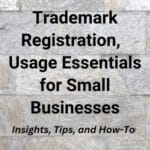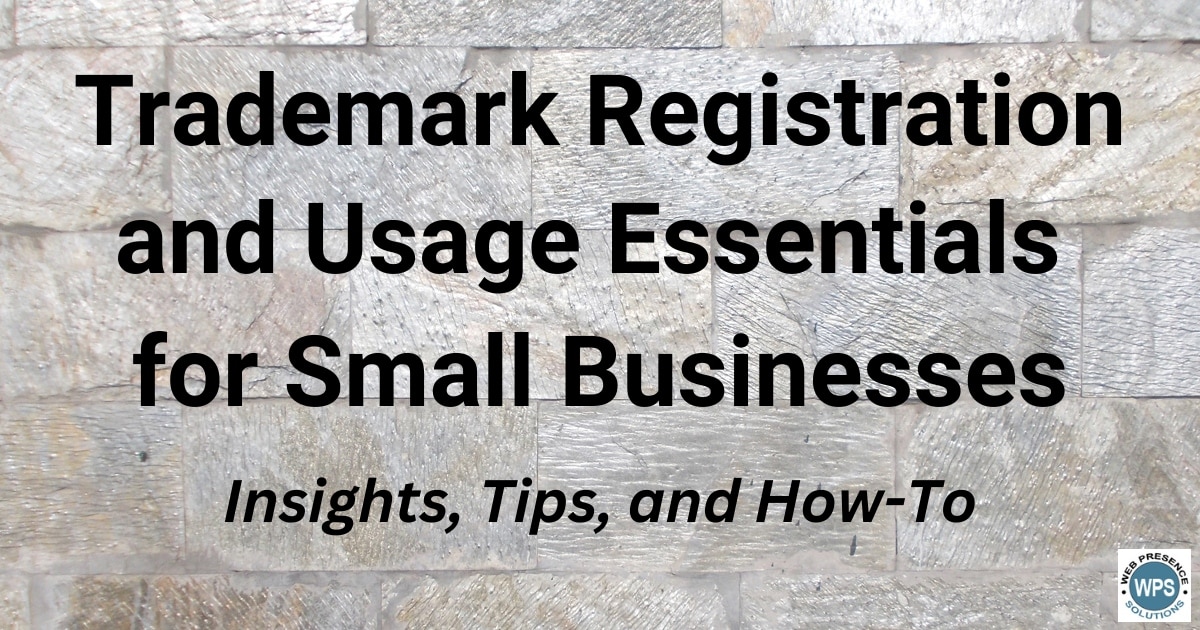Establishing a strong and recognizable brand is a crucial element for business success. Trademark registration is one of the most effective steps in building your brand.
Do you have a registered trademark for your business?
If not, you may wonder, “Do I need one“?
For a small regional business or a new startup, registering a trademark may not be at the top of the priority list.
Making it a higher priority is a sound business investment. A trademark secures your brand’s identity and provides legal protection against infringement.
Whether you’re an entrepreneur, a small business owner, a content creator, a podcaster, or a social media influencer, understanding the ins and outs of trademark registration is essential.
All trademark registrations in the US go through the United States Patent and Trademark Office (USPTO). And they’re busy, as shown here:
“The USPTO received 787,795 trademark application classes for registration in FY 2022.” (USPTO)
This post will clarify the process of obtaining and using a registered trademark in the United States, the different types of trademarks, and why a trademark is important for a business.
Additionally, we’ll explore common questions ranging from the basics of a trademark to trademark renewal, to specific scenarios like trademarking digital assets such as YouTube channels, Instagram accounts, podcasts, and even Facebook pages.
Important Note: This article is not meant to provide legal advice. For professional trademark assistance, you should contact a legal firm or attorney.
Trademarks – Registration, Usage, Maintenance
1. What is a Trademark?
Let’s start with the basics. What is a registered trademark? According to the United States Patent and Trademark Office (USPTO):
“A trademark is a word, phrase, symbol, and/or design that identifies and distinguishes the source of the goods of one party from those of others. A service mark is a word, phrase, symbol, and/or design that identifies and distinguishes the source of a service rather than goods. Some examples include brand names, slogans, and logos. The term “trademark” is often used in a general sense to refer to both trademarks and service marks. “
“Unlike patents and copyrights, trademarks do not expire after a set term of years. Trademark rights come from actual “use” (see below). Therefore, a trademark can last forever – so long as you continue to use the mark in commerce to indicate the source of goods and services. A trademark registration can also last forever – so long as you file specific documents and pay fees at regular intervals.”
Trademarks are identified as a mark – ™ or as a registered mark ®. These trademark symbols can be used in retail stores, business websites, online marketplaces (Amazon, eBay, Etsy), product packaging, branding, advertising, and marketing material. The USPTO stipulates how and how often the marks need to be used.
Important Note: You don’t receive a federally registered trademark when registering your business with your state or incorporating your business. Receiving a registered trademark is a separate process that must go through the USPTO.
2. Why is Trademark Registration Important for a Business?
Forty years ago, having an ecommerce business wasn’t really a thing. Local retail businesses didn’t face the same challenges as nationwide or international businesses or brands. Like so many other areas, the Internet changed that.
In the rapidly growing and changing online world, having a registered trademark for your business, its essential products, logos, and, potentially, your social media profiles can provide significant benefits and protections.
Benefits of Trademark Registration include:
Protection for Your Business
A US-registered trademark can protect your business and brand from being used by others. It can also protect unique product names and logos.
Trademarks can also protect digital assets such as YouTube channels, Podcasts, Instagram Names, and Facebook Pages. A business with a registered trademark has clear legal recourse against anyone using or infringing on the registered trademark.
Protect Against Brand Damage
A trademark can protect your brand from damage and counterfeits. In the online world, you can protect your brand nationwide or internationally from being damaged by others using it, copying it, or counterfeiting your products.
Other businesses using your branding without permission can potentially cause significant damage to your brand, loss of sales revenue, and negatively impact perceptions of your products and your business. Counterfeiting is theft.
Trademark Protection In Ecommerce Marketplaces
Some ecommerce marketplace platforms, such as Amazon, eBay, Etsy, and Walmart, provide added opportunities for businesses with a registered trademark. An excellent example is the Amazon Brand Registry program, a free program requiring a company to have a registered trademark to join.
Intellectual Property Protection and Value
A business name, logo, slogan, product name, domain name, and social media profiles are forms of intellectual property (IP). Protecting that IP is a sound strategy, especially with a startup, e-commerce, or entrepreneurial business.
Intellectual property, such as a trademark, adds value to a business, including if it is sold or acquired.
Brand Image
A registered trademark for a business, especially a startup company or a fast-growing ecommerce business, can potentially convey authority, longevity, and even strength when used regularly and effectively.
3. What Items Can A Business Trademark?
When considering what elements of your business to trademark, the key is to consider what aspects of your brand are unique and how they help your customers distinguish your products or services.
Items such as a business name, a person’s name, a product name, or a logo are the most common business elements that receive registered trademarks.
Tradmarking Social Media Assets
“Can I register a trademark for my social media assets such as a Podcast, YouTube channel, Instagram Name, Facebook Page, or a hashtag?”
Yes, getting a registered trademark for social media properties is possible. Be sure to include these in your trademark search when registering.
Even if your business is a YouTube Channel, a Podcast, or an Instagram Name, you may be able to receive a registered trademark.
It’s important to ensure that any elements you are considering for a registered trademark meet the legal requirements, such as distinctiveness and use in commerce.
Here are some of the key business elements you can register as trademarks:
- Business Name
The name under which your business operates can be trademarked to protect the identity of your business itself. - Brand Names and Logos
The most common use of trademarks is to protect brand names and logos. These symbols and words identify your business and its products or services to consumers. - Product Names
Specific names of products that your business manufactures or sells can be trademarked. This helps in distinguishing your products from those of competitors in the market. - Service Names
Much like product names, the names of services you provide can also be trademarked. This is particularly important for service industries like finance, education, and hospitality. - Slogans and Taglines
Short phrases or slogans used in marketing and advertising that are distinctive and memorable can be trademarked. These often communicate your brand message or value proposition. - Domain Names
While domain names are usually not trademarked, if your domain name is also used as a brand identifier for your goods or services, it can be eligible for trademark protection. - Trade Dress
This refers to the distinctive visual appearance of a product or its packaging that signifies the source of the product to consumers. It can include shape, color, texture, graphics, or specific sales techniques. - Character and Celebrity Names
Names of characters or celebrities can be trademarked, especially if they are used to brand products or services.
4. How Do I Search for Existing Trademarks?
A comprehensive trademark search is essential to applying for a registered trademark. This can avoid unforeseen and potentially costly problems in the future.
Even before applying for a trademark, a search of the USPTO database, state databases, and other locations. This search helps ensure that the trademark you want to use is not already taken or too similar to an existing one, which could lead to legal disputes or rejection of your application.
Here’s how you can conduct a thorough search for existing trademarks:
1. Understand What You’re Searching For
Before you start, clearly define what you’re searching for – this could be a name, logo, slogan, YouTube channel, Podcast, Instagram name, or a combination of these. Knowing precisely what your trademark consists of will help streamline your search.
2. Use the USPTO’s Search System
In the United States, the primary resource for conducting a trademark search is the United States Patent and Trademark Office’s (USPTO) Trademark Electronic Search System (TESS). TESS is a database of registered trademarks and pending applications.
3. Conduct a Basic Word Mark Search
Start with a basic word mark search if your trademark is primarily text-based. This will show you direct matches and similar-sounding marks. Pay attention to phonetic similarities and variations in spelling.
4. Search for Design Marks
If your trademark includes a design element, use the design search code manual provided by the USPTO. This is more complex as it involves searching through design codes assigned to various graphical elements.
5. Consider Variations and Similarities
Look for trademarks that are identical and similar enough to cause confusion. This includes similar-sounding names, visual similarities in logos, or synonyms.
6. Check State Registries and Online Platforms
Additionally, consider searching state trademark databases, as trademarks can be registered at the state level. Also, conduct searches on internet search engines, social media platforms, and domain name registries to see if the mark is being used but not registered.
7. International Searches
If you plan to do business internationally, consider searching international databases such as the World Intellectual Property Organization (WIPO) Global Brand Database.
In the end, conducting a thorough trademark search can be time-consuming, but it’s crucial to protecting your brand and avoiding future legal complications. If you don’t have the time or the interest, consider hiring a professional. They will have trademark search experience and access to specialized databases for a more thorough investigation.
A Lesson in the Value of a Trademark
An example of the impact of registered trademarks and intellectual property (IP) was shown in the article “What Brand Owners and Small Businesses Can Learn from Backcountry.com’s Trademark Enforcement Campaign.“
The U.S.-based online outdoor goods retailer Backcountry.com, based in Park City, UT, and their legal counsel decided to take action against a large number of companies that used the term “backcountry” in their names.
They filed lawsuits against smaller companies, including American Backcountry, Backcountry Babes, Marquette Backcountry Skis, Backcountry Denim Co., Backcountry Nitro, Cripple Creek Backcountry and others. Thnigs did not go as planned. The results were illuminating.
5. How Do I Get A Registered Trademark For My Business?
There are three basic ways to get a registered trademark. Each has pluses and minuses. A key factor, as with many things, may be your budget. Here is a short description of the options:
1. Filing the registration application yourself.
DIY. Avoid the upfront costs of a professional service or attorney by doing the necessary research, performing a comprehensive trademark search, completing and filing all forms, and handling correspondence with the USPTO.
This option allows you to utilize various online information, resources, and research tools. This will require much more of your time than the other options.
2. Hire an online legal service such as Legal Zoom, Rocket Lawyer, or Trademark Engine.
There are quite a few online. Generally, these services will do a trademark search, review what is being trademarked, and prepare and submit the application to the USPTO.
The final cost can be affected by the effectiveness of the trademark search and any complications that arise during the application process.
3. Hire an attorney or law firm that specifically provides trademark services.
An attorney will likely cost the most but will also handle all aspects of the trademark registration process, including responding to any communications from the USPTO during the process.
The scope of the trademark search may be more in-depth when performed by an attorney. Another potential benefit of working with an attorney is that they will notify you when it is time to renew your trademark. The USPTO will not.
In summary, each trademark registration option has pluses and minuses, including cost, time required, and potential errors and delays.
Your best option may be to explore all three avenues to see which works best for your needs and requirements.
6. Can I Register a Trademark, or Do I Need an Attorney?
Whether you can register a trademark or need an attorney is an important consideration when embarking on the trademark registration process. In the United States, it is possible to register a trademark on your own. Still, several factors must be considered when deciding whether to do it yourself or hire an attorney.
Registering A Trademark Yourself:
• Cost-Effective: Cost savings are the primary advantage of filing a trademark application on your own. You will only be responsible for the filing fees required by the United States Patent and Trademark Office (USPTO).
• USPTO Resources: The USPTO website provides resources and guides to help individuals understand the process. These resources are helpful for straightforward trademark applications.
• Direct Control: Handling the process yourself gives you direct control over the application and immediate awareness of any correspondence from the USPTO.
• Simplicity for Uncomplicated Marks: The process can be more manageable if your trademark is straightforward (e.g., a unique name or logo not similar to existing trademarks).
Challenges of DIY Trademark Registration
• Complexity of Trademark Law: Trademark law can be complex. Understanding the nuances of what makes a trademark registrable and how to respond to USPTO office actions (if your application is initially rejected) requires a certain level of expertise.
• Risk of Errors: Mistakes in the application process can be costly and time-consuming. Errors can lead to the rejection of your application.
• Search Limitations: Conducting a comprehensive trademark search to ensure your mark doesn’t infringe on existing trademarks can be challenging without access to specialized databases or legal expertise.
• Responding to Legal Issues: If legal issues arise, such as an opposition to your application or a need to argue against a refusal, navigating these without experienced legal help can be difficult.
Hiring a Trademark Attorney
• Expertise and Experience: Attorneys specializing in trademarks can provide expert advice, ensuring your application is accurately prepared and increasing the likelihood of approval.
• Comprehensive Search: Attorneys can conduct a thorough trademark search and offer legal opinions on the likelihood of registration success.
• Handling Complexities: An attorney can handle complexities such as responding to USPTO office actions or opposition proceedings.
• Long-Term Strategy: Attorneys can advise on a broader intellectual property strategy, ensuring your trademark aligns with your business goals.
• International Registration: If you’re considering international trademark protection, an attorney can navigate the complexities of filing in multiple jurisdictions.
Therefore, while it is possible to register a trademark on your own, the decision should be based on the complexity of your mark and your familiarity with the trademark registration process. Another consideration should be your willingness to manage any potential legal challenges.
For more complex situations or if you’re unsure about any aspect of the process hiring a trademark attorney maybe the optimal solution.
7. How Much Does Trademark Registration Cost?
The cost of registering a trademark can vary depending on several factors, including the geographical scope of the registration, the number of classes of goods or services you are registering, and whether you hire a professional to assist with the application.
Here’s an overview of the costs associated with registering a trademark in the United States:
1. USPTO Filing Fees
The United States Patent and Trademark Office (USPTO) charges a filing fee for each trademark application. The fee can vary depending on the filing basis and the method of filing. Fees currently range from $250 – $350 per trademark.
These fees are subject to change, so checking the current fee schedule on the USPTO website is important.
2. Legal Fees
Legal fees can significantly add to the cost if you hire a trademark attorney to assist with your application. Attorney fees for trademark registration can vary widely based on the complexity of your application and the attorney’s rates.
Some attorneys charge flat fees for a trademark application, while others charge hourly rates. Legal fees can range from a few hundred to several thousand dollars. Rates may vary, so it can pay to shop around.
3. International Registration Costs
If you want to protect your trademark in countries outside the United States, the costs will increase. Each country has its own trademark office and fee structure.
4. Additional Costs
There may be additional costs for things like conducting a comprehensive trademark search, responding to USPTO office actions (if your application initially receives objections), or trademark renewal (trademarks in the U.S. need to be renewed between the 5th and 6th year after registration, and every ten years after that).
5. Potential Opposition Proceedings
If someone opposes your trademark application, or if you need to oppose someone else’s application, the costs can increase significantly due to legal fees and potential litigation costs.
While the basic filing fees might seem straightforward, the total cost of registering a trademark can vary widely based on your specific circumstances. This can be especially true if legal representation is involved or you seek international protection. It’s vital to budget not just for the initial application fees but also for potential additional costs along the way.
8. Trademark Renewals – How Long Does a Trademark Last
The duration of a trademark’s validity is an important aspect of trademark law. Understanding trademark renewals can help in effectively managing and protecting your intellectual property.
Important Fact: Registered Trademarks need to be renewed periodically. Not doing this can cause your trademark protection to lapse. A trademark can last indefinitely in the United States, but there are specific requirements for trademark renewals to maintain its protection over time.
Trademark Renewal Requirements
To maintain the trademark, you must file a renewal application. The first renewal is due between the 5th and 6th year after registration. This renewal requires a Declaration of Use (or Excusable Nonuse), proving that the trademark is still used in commerce.
Subsequent Trademark Renewals
After the first renewal, you must renew the trademark every ten years. Each renewal requires a new Declaration of Use and the payment of renewal fees.
Maintaining Trademark Rights
Continuous Use
The trademark must be continuously used in commerce to keep the trademark rights. If the mark is not used for a prolonged period (usually three years or more), it may be considered abandoned, and rights to the trademark could be lost.
Proper Use
Proper use of the trademark is also essential. This means using the mark in the form it was registered and on the goods or services specified in the registration.
Monitoring and Enforcement
The trademark owner is responsible for monitoring and enforcing their trademark rights. This includes acting against unauthorized use or infringement.
Loss of Trademark Rights
Trademark Non-Renewal
If the required renewals are not filed, the trademark registration will expire, and the legal protections provided by registration will be lost.
Trademark Abandonment
If a trademark is not actively used, it can be deemed abandoned. Other parties can petition to cancel the registration if they prove the mark hasn’t been used.
So, while a trademark can potentially last indefinitely, this is contingent on the business trademark being actively use in commerce and properly renewed at the required intervals. Therefore, ongoing management and vigilance are vital to maintaining a trademark over the long term.
9. What is the Difference Between ™ and ® Symbols?
The symbols ™, SM, and ® play essential roles in trademark law, each representing a different status of a trademark’s registration and usage.
Understanding the difference between these symbols is crucial for businesses and individuals in correctly representing their trademark rights.
Here’s a breakdown of each symbol and its appropriate use:
™ – Trademark Symbol
1. Meaning: The ™ symbol stands for “trademark” and is used to signify that a word, phrase, logo, or other symbol is being claimed as a trademark.
2. Usage: This symbol can be used regardless of whether a trademark application has been filed with the United States Patent and Trademark Office (USPTO) or any other trademark office. It’s often used for products.
3. Purpose: By using ™, the owner publicly states their claim to the trademark, which can be a critical factor in establishing legal rights, especially in common law trademark rights in the U.S.
SM (Service Mark Symbol)
1. Meaning: The SM symbol stands for “service mark” and is similar to the ™ symbol but is used explicitly for services instead of tangible goods.
2. Usage: Like ™, the SM symbol can be used without filing for federal registration. It’s a way to claim rights in a mark for services offered.
3. Purpose: Using SM indicates that the owner claims rights to the service mark and can be essential to establishing and maintaining legal rights.
® – Registered Trademark Symbol
1. Meaning: The ® symbol indicates that a trademark or service mark has been officially registered with the USPTO or the corresponding trademark authority in another country.
2. Usage: This symbol can only be used after the trademark office formally registers the trademark and not while an application is pending. Improper use of the ® symbol can have legal implications, including claims of fraudulent representation.
3. Purpose: The ® symbol notifies the public that the mark is registered and provides legal notice of ownership. It also strengthens the owner’s ability to enforce trademark rights, including in infringement cases.
Key Differences and When to Use Each Trademark Symbol
™ vs. SM: The choice between ™ and SM depends on whether the mark is used for goods (™) or services (SM). Both symbols indicate that the mark is being claimed as a trademark or service mark, respectively, but neither indicates that the mark is registered.
®: This symbol is exclusively used for marks that have achieved registered status and should not be used before official registration is confirmed.
In summary, ™ and SM are used to assert rights over a trademark or service mark, respectively, without needing registration. In contrast, ® indicates that a trademark has been officially registered.
Correctly using these symbols is essential for legal protection of the mark and compliance with trademark laws.
10. How to generate the Trademark ™ and Registered Trademark ® symbols from a computer keyboard
We’ve all gone through it at one time or another – wondering how one generates the actual symbols for a trademark or a registered trademark. Here is how:
On a Windows computer:
Use a keyboard combination of pressing the [ALT] key followed by the keypad number sequence of “0153” to insert the Trademark symbol: ™ (important to use the numeric keypad)
Use a keyboard combination of pressing the [ALT] key followed by the keypad number sequence of “0174” to insert the Registered Trademark symbol ®
** It is important to use the numeric keypad and not the number keys at the top of the keyboard
On Apple operating systems
Hold the [Option] and “2” keys at the same time to insert the Trademark symbol: ™
Hold the [Option] and “R” keys at the same time to insert the Registered Trademark symbol ®
Programs such as Microsoft Word or Google Docs also allow you to look up symbols from within the program and insert them into a document.
Thoughts From A Trademark Owner
Here are some words of wisdom from Susan RoAne, Keynote Speaker, author of “How To Work A Room(r), and someone who has extensive direct experience applying for, using, and monitoring multiple trademarks and copyrights over the last 30+ years:
• “One aspect of hiring an attorney: Only hire an experienced Patent and Trademark Attorney, not cousin Joan, who is a lawyer, but NOT a patent and trademark attorney.”
• “Another important benefit about hiring an attorney of note: They will remind you of when it’s time to renew. The USPTO will not remind you when it’s time to re-up.”
• “Once you get the patent, trademark or registered mark, get Google Alerts on that name or term so you know who is using it. And then you can address their misuse or infringement.”
Important Note: Remember, this post is not meant to provide legal advice. For professional trademark legal assistance, you should contact a legal firm or attorney.
Trademark Registration Conclusions
Trademark ownership and protection can be a valuable asset for a business. As the value of your business grows, your trademarks will also grow in value.
Additionally, be sure to get sound advice when registering a trademark. There are many good free or inexpensive resources available. Just doing a trademark search can be informational and verify that no one else has registered a trademark for your business name.
Finally, for a new business or startup, do a registered trademark as soon as possible. Before you invest a lot of time and money building your business and brand name, make sure someone else isn’t already using it and that you can register a trademark for that name.
Next Steps:
Now would be an excellent time to explore trademarks if you don’t have a registered business trademark.
If you have a registered trademark be sure to have a clear trademark renewal process. Make sure all of your trademarks are current.
Additional Trademark Registration Resources
The United States Patent and Trademark Office (USPTO) has a great deal of information about trademarks and registered trademarks. Here is a good starting point: USPTO Trademark Basics
Trademarks and Social Media: What Small Business Owners Need to Know – “Here are a few tips on how small businesses should handle trademark issues in the world of social media.”
Why every retailer needs to register a trademark – “Before investing extensive time and money developing your brand, it is essential for you to determine whether your brand infringes on any existing business.”
What can influencers protect with a trademark registration?
“New businesses have the challenge of creating and developing successful brands, but influencers have the challenge of turning a successful brand into a well-protected and long-lasting business.”
Handpicked Related Posts from Our Blog (click on the icon)




